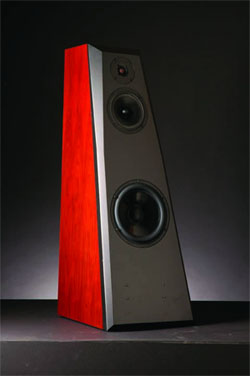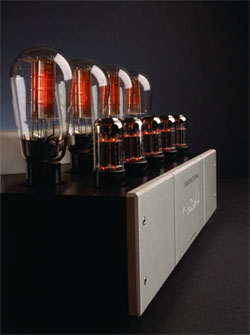| The Aurum acoustics system combines simplicity and musicality
by Listening Panel
Aurum Acoustics has been in the consumer electronics business since 2005. Its founder, system designer and president Derrick Moss holds an engineering degree and a masters in business. As a young man, he became an enthusiastic audiophile, which inspired him to focus on the issue of synergy, assemble the necessary components and create an audio system that works on good-old-fashioned principles integrated with innovative ideas.
Appearance
It's important to note that, although these components are meant to be used as a system to accomplish synergy, they can be used individually. All told, the system consists of a pair of loudspeakers with active crossovers; a dual mono amplifier (the Integris Active 300B amp and dedicated speaker combo are US$30,000) that is accommodated on a rather large chassis; a CD player that doubles as a preamplifier (Integris CDP, US$12,000); and a stand (Integris, US$3,000) that supports the two components. Finally, it's all connected with the Integris two metre power cords priced at US$800 each.
|

Aurum's CD player uses design parameters from Anagram.
|
The loudspeakers are a statement of refined, effortless beauty. The component's handsome stand is a two-shelf design. The amplifiers accommodated on one chassis are placed on the lower shelf, their silver faceplate displaying the Aurum logo. On the chassis top, four 300B and five 6NS7 vacuum tubes glow seductively when the unit is in operation. The CD player/preamplifier has a matching silver faceplate with the various controls logically arranged. This is a marvelous system uncomplicated, neat, and a complement for any decor.

The speakers of the Aurum Acoustics Active 300B System rely on active crossover technology.
|
The Sound
It is difficult to describe the performance of a single electronic component as it interacts with associated equipment, and an evaluation must take the entire system into account. Reviewing a system such as the Aurum Acoustics precludes all assumptions since the only element of significance is its musical performance. In this light, not only does the system rate very highly, it truly challenges the very way we do evaluations.
First of all, let us describe how engaging the overall sound is; it is effortless, intimately musical and involves the listener with the very texture of the music, its instruments and/or vocalists. We rarely mention the program material used for evaluations as we feel that choosing listening material should be left to the end-user. However, this time around we will document some listening material as we'd like our readers to know a bit more about how we came to our conclusions. One of our standard auditioning CDs is the Adagio d'Albinoni performed by Gary Kaar on an classic Amati contrabass built in the 1700s. The instrument's amazing range, its timbre, and overall tonal property is unique and the system clearly revealed its distinctive elements. On many good systems, the sound is stunning, but few actually capture the spirit and soul of this instrument as well as the Aurum Acoustics set-up. For another wonderful and revealing listening test we used the Todo Sobre Di Madre CD (Spanish Universal 626208-2) This full orchestral work contains big bass drums, electronic music, violins, trumpet and the kitchen sink; it's a workout for any and all audio components. The AA system handled the material effortlessly and with a perspicuity that allows literally hearing into the performance; this translates into transparency and sound that is never strained or synthetic. |
| We love the sound of Hammond B3s (see Notes From The Editor's Desk, in the last issue) and, as a further test, played back some of our older recordings made with the original B3 and some newer discs that feature the new Hammond/Suzuki B3. On most systems the two different B3s cannot be distinguished, but on the Aurum Acoustics system, the instruments' slight dissimilarities came through loud and clear. We feel that the system's strength is its ability to extract and render lower midrange and upper bass harmonics. This enhances the listening experience at very low volume levels. Additionally, the system maintains a remarkable tonal counterbalance in the upper frequencies which, again, assists low-level listening. However, at low volumes, pure midrange is slightly subdued and not as clear as it hypothetically could be. At high gain (volume), however, this simply is not at all noticeable.
Some of our panelists took to the system's sound like butterflies to flowers and had no beef at all. Others, however, stated that while they liked upper and lower midrange (the range from about 150Hz to about 1,400Hz) they thought the bass was a bit lush and the highs were a touch too energetic. The Editor's take on these comments is that some folks will opine in favour of their own system, their standard and their bias.
Nevertheless, the Aurum Acoustics system is a sophisticated assembly of rather expensive components, arranged to perform in a musically pleasing manner that will appeal to almost all who can recognize good sound when they hear it. |

The seductive glow of the dual mono Integris Active 300B amplifier
|
Synopsis & Commentary
The Aurum Acoustics system is a powerful affirmation of component synergy, which is the core editorial argument we have been making for a long time about what constitutes a high-end system. We feel that it would be quite difficult to achieve the superb sound of the Aurum Acoustics system with separate components without spending additional thousands. We aren't going to to tell you that it's impossible, but we are saying that to find and assemble such a system would be almost as difficult as trying to ski through a revolving door.
The system's components are carefully chosen to perform at their best when interconnected. But the real benefit is that, in addition to the elevated degree of technical proficiency, the Aurum system's performance is musically pleasing. Obviously, the system was designed for those who appreciate operating simplicity and musicality. Those who are inclined to modify or tweak should know that there is nothing to tweak and any attempt will just change the sound, not improve it. We advise those who are in the market for a complete system to listen to the Aurum Acoustics; if you like what you hear buy it. If you don't like it, and there will be some, well, it will have to be separate components to customize the sound that will please you. However, we believe that the Aurum Acoustics system is difficult to beat. It's both simple and complex, but it is high-end audio perhaps a perfect example of the old saying that simplicity is complexity resolved.
| MODELS |
MANUFACTURER |
| Active 300 B System |
Aurum Acoustics |
| RATING |
CONTACT |
♪♪♪♪
|
Aurum Acoustics 709.834.8244 www.aurumacoustics.com |
| PRICE |
|
| $48,000 (system)
US |
|
| DIMENSIONS |
WEIGHT |
4.4 (h) 19 (w) 14 (d) (CDP)
43.3 (h) 15.7 (w) 17.5 (d) (speakers)
10 (h) 19 (w) 23 (d) (amp)
21.5 (h) 19 (w) 23 (d) (stand)
|
29 1bs (CDP)
110 lbs (speakers)
70 lbs (amp)
50 lbs (stand) |
| FINISH OPTIONS |
|
| Honey Gold Burl, Rosenut Veneer |
|
|
 |
TECHNOLOGY
The single chassis actually holds six mono amplifiers. The vacuum tube amps are used to drive the loudspeakers midrange and high frequencies, while the bass is driven with a modular Bryston amplifier. The four 300B-based amps provide 5 watts per channel and drive the loudspeakers via a 6NS7 tube preamp/active crossover stage. The Bryston delivers 100 watts per channel to the woofers driving them via a two-stage 6NS7 preamplifier buffer circuit and a solid state crossover. All crossovers are located on this chassis and no interconnects are used. On the rear of the chassis two sets of cables connect to the loudspeakers. For each enclosure, the midrange and tweeter drivers connect with one single (shotgun) XLR-type connector using Cardas 8.5awg cable. This cable was specifically designed for use with single-ended vacuum tube amplifiers. For the bass drivers, 15.5awg Cardas cables are employed as they are designed for solid state bass amplification. The same wiring is used for internal connections inside the amplifier.
The loudspeakers are three-way designs with a twist. The drivers have been carefully chosen to function at their optimal operating condition when connected to the dedicated amplifiers. As they are without crossovers (active crossovers on the amplifier chassis control frequency allocation), two sets of speaker terminals have been installed; the midrange and tweeters connect with an XLR termination, and the bass drivers are connected with one of the new terminals that allow tightening without using a wrench. The enclosures' shape prevents internal standing wave problems as they are inclined by an eight degree slope on one side and a ten degree slope backwards. They are thoroughly braced and our tests confirmed all-out rigidity without resonance. It's easy to see that every design element has been meticulously addressed. Nothing has been left to chance, nothing has been missed and no shortcuts are apparent.
The preamplifier/CD player is based on the design of the Swiss company Anagram whose digital circuitry also appears in the Audio Aero players. The preamp section of the player is, while not in the league of the Audio Aero Prestige player (reviewed in the last issue), still quite respectable. We had examined the preamp stage of the Audio Aero Capitole player (reviewed in Vol. 15, NO2), and found it's output stage very musical. The Aurum player, which bears a resemblance to the Capitole model, may have some mods in the output stage to conform to the Aurum's amplifier specifications. |
|



